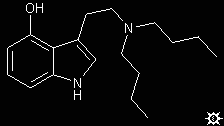
#15. 4-HO-DBT

|
| [3D .mol Image] |
To a stirred suspension of 0.50 g LAH in 10 mL anhydrous THF stirred under nitrogen, at room temperature, there was added a solution of 0.78 g 4-acetoxyindol-3-yl-N,N-dibutylglyoxylamide in 10 mL anhydrous THF. This was added dropwise at a rate that maintained the reaction at reflux. When the addition was complete, the reflux was maintained for an additional 15 min and then the reaction was cooled to 40 °C. The excess hydride and the product complex were destroyed by the addition of 1.0 mL EtOAC followed by 3.0 mL H2O. The solids were removed by filtration, the filter cake washed with THF, the filtrate and washings pooled, and the solvents removed under vacuum. The residue was distilled at the KugelRohr and the distillate recrystallized from EtOAc / hexane. Thus there was obtained 0.20 g (35%) of 4-hydroxy-N,N-dibutyltryptamine (4-HO-DBT) with a mp 74-75 °C. C,H,N.
DOSAGE : >20 mg, orally
DURATION : unknown
QUALITATIVE COMMENTS : (with 20 mg, orally) "No effect."
EXTENSIONS AND COMMENTARY : This was a total disappointment. With the remarkable activity of the diisopropyl compound (4-HO-DIPT) this seemed to be a promising candidate for activity. Especially interesting would be the di-sec-butyl isomer with the same branching of the chain right at the position of attachment to the basic nitrogen atom.
Let me ask the chemist who is reading this at the moment, to allow me a moment to present to the non-chemist a lay definition of what is being talked about here. This is one of the most exciting, and most annoying, tidbit of what could be called isomeric aliphatic chain branching. Please, all non-chemists, forget that I used that phrase. Let me give a simple demonstration of the weird terms (such as methyl, ethyl, propyl, butyl) and prefixes (such as normal, iso, secondary, tertiary) that have been part and parcel of this second half of the book. Let me give you, hypothetically, any number of tennis balls (my metaphor for carbon atoms) from one (initially) to four (at which point I will abandon ship). You are to put them (however many you have) up against the tennis net in every possible way.
You have one tennis ball. There is only one way you can do it. There is the net (the nitrogen atom with an implacable point of attachment, that can touch only one ball at a time, at least in this example), and here is the ball (the carbon atom that has to be attached to it):
| N - C | one carbon is methyl, there is only one way it can be attached | ||||||||
| Now you have been given two tennis balls: | |||||||||
| N - C - C | two carbons is ethyl, there is only one way you can attach them | ||||||||
| Now you have been given three tennis balls: | |||||||||
| N - C - C - C | three carbons is propyl, this is one way they can be attached (known as propyl) | ||||||||
| But a second possibly emerges: | |||||||||
|
the third tennis ball can touch the first rather than the second ball (known as isopropyl) | ||||||||
| Now you have been given the fourth tennis ball: | |||||||||
| N - C - C - C - C | four carbon atoms is butyl, this is one way they can be attached (known as normal butyl), | ||||||||
|
the fourth ball can touch the first, this is another way they can touch (known as secondary butyl) | ||||||||
|
the fourth ball can touch the second, this is yet another way they can touch (known as iso butyl, or i-butyl), | ||||||||
| (of course, if the fourth ball touches the third, you have the normal butyl as shown above) | |||||||||
|
the third and fourth ball can touch the first one -- this is the fourth way they can touch (known as tertiary butyl) | ||||||||
Back to the rational world. Two n-butyl groups gives the compound 4-HO-DBT, the theme of this recipe. It is not active at 20 milligrams, but I suspect that it will be so at a somewhat higher dose. There is the secondary-isomer, 4-hydroxy-N,N-di-s-butyltryptamine (4-HO-DSBT, an oil that never crystallized) which should be an isomer of increased activity, but it has not been assayed. The iso-isomer (4-HO-DIBT, mp 152-154 °C) should be yet less active as the steric mess around that important nitrogen atom is much larger, and indeed it is not active at the same 20 milligram level. The tertiary isomer (4-HO-DTBT) has yet to be made and, as it is extremely crowded around that innocent nitrogen atom, it may be unmakable. The activity is unknown, as the compound itself is unknown. The four methyl butyl possibilities are all known, and are mentioned in the recipe for 4-HO-MPT.